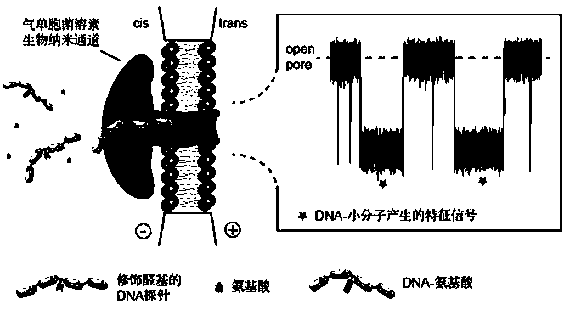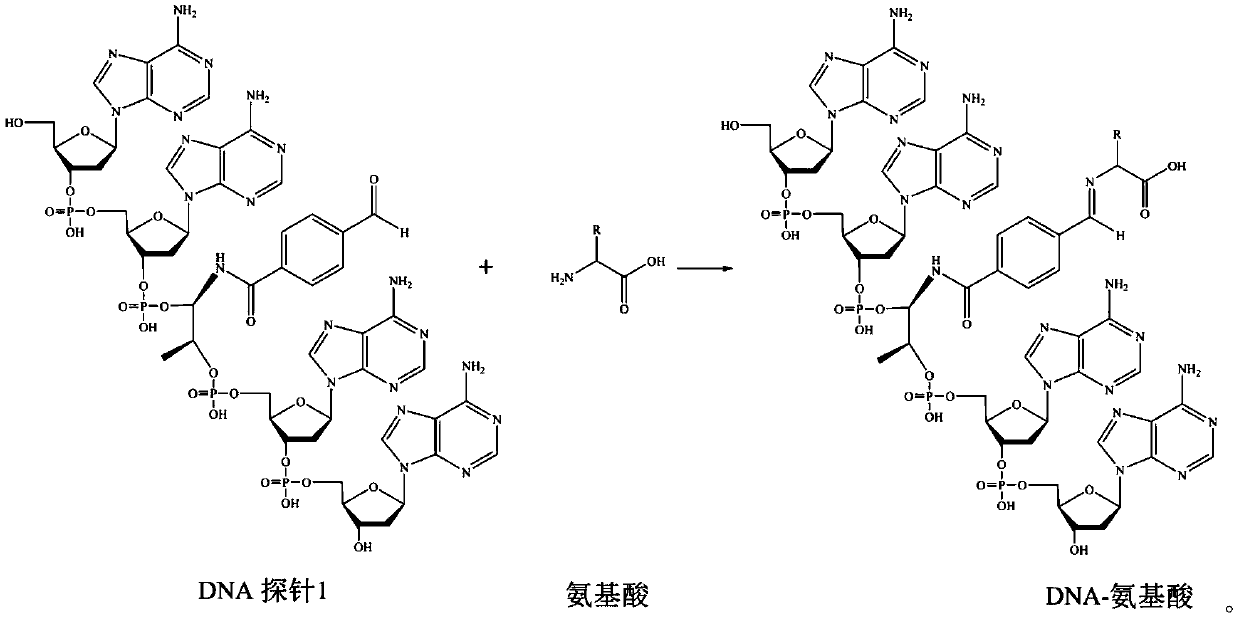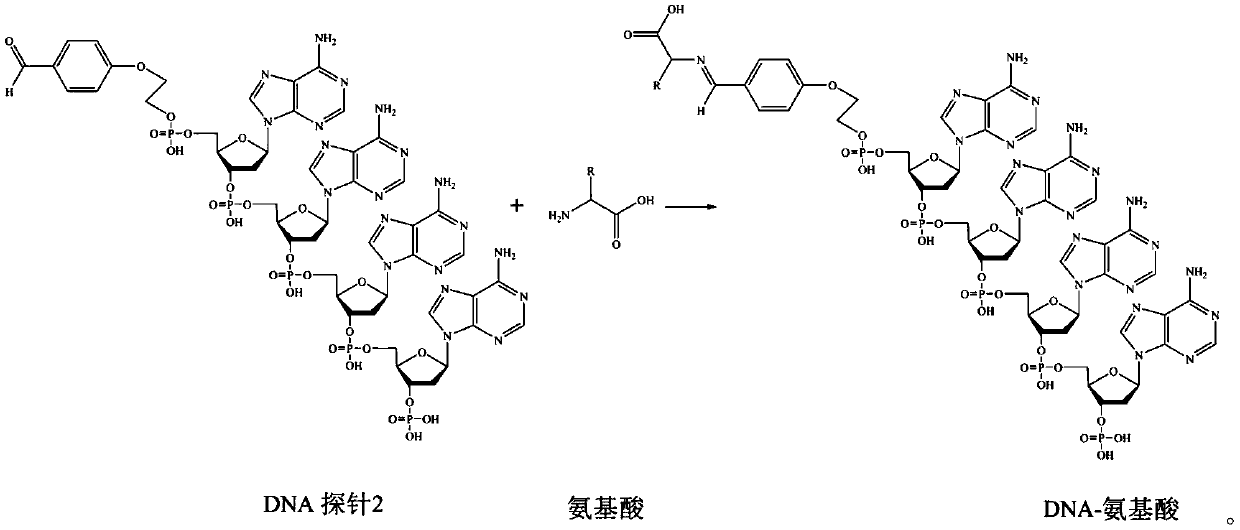Method for detection of amino acids based on aerolysin nanochannel
A technology of aerolysin and nanochannels, applied in the direction of material electrochemical variables, etc., can solve the problems of complex operation, few, high cost, etc., and achieve the effect of convenient operation, active clinical treatment, and low price
- Summary
- Abstract
- Description
- Claims
- Application Information
AI Technical Summary
Problems solved by technology
Method used
Image
Examples
Embodiment 1
[0043] see figure 1 . A method for detecting amino acids based on aerolysin nanochannels for detecting cysteine, comprising the following steps:
[0044] (1) Designing DNA probe 1 and DNA probe 2, the DNA probe 1 and DNA probe 2 are connected with aldehyde groups, and the length of the bases is 4.
[0045] The mechanism of the reaction of the DNA probe 1 with the amino acid is:
[0046]
[0047] The mechanism of the reaction of the DNA probe 2 with the amino acid is:
[0048]
[0049] (2) Mix 20 μL, 200 μM, DNA probe 1 or DNA probe 2 solution with a pH value of 8.0 and 10 μL, 5 mM cysteine solution with a pH value of 7.0 to 9.0, and place it at 70 ° C for 10 hours , using the addition reaction of aldehyde group and amino group to connect cysteine to DNA probe.
[0050] (3) Preparation of aerolysin bionanochannels
[0051] ① Activated aerolysin
[0052] Dissolve aerolysin in trypsin-EDTA solution, the ratio of aerolysin to trypsin-EDTA solution is 1:100; place it ...
Embodiment 2
[0069] A method for detecting amino acids based on the aerolysin nanochannel is used for detecting histidine, and the basic steps are the same as those in Example 1.
[0070] The difference is:
[0071] (1) (with embodiment 1).
[0072] (2) Mix 20 μL, 200 μM, DNA probe 1 or probe 2 solution with a pH value of 8.0 and 10 μL, 500 mM, pH value of 8.0 histidine solution, and place it at 70 ° C for 10 hours to utilize the aldehyde group Addition reactions with amino groups link histidine to DNA probes.
[0073] (3) (with embodiment 1).
[0074] (4) Detection of histidine with aerolysin
[0075] ③ Acquisition of DNA probe-histidine single molecule signal
[0076] The obtained DNA probe-histidine reaction solution is added to the cis detection pool; the DNA probe-histidine single-molecule characteristic signal is collected—this signal is a single-molecule signal that can reflect the characteristics of histidine.
[0077] 4. Example 2 Statistically collects the DNA probe-histidin...
Embodiment 3
[0079] A method for detecting amino acids based on the aerolysin nanochannel is used for detecting alanine, and the basic steps are the same as those in Example 1.
[0080] The difference is:
[0081] (1) (with embodiment 1).
[0082] (2) Mix 20 μL, 200 μM, DNA probe 1 or DNA probe 2 solution with a pH value of 8.0 and 10 μL, 500 mM, alanine solution with a pH value of 8.0, and place it at 70 ° C for 10 hours. The addition reaction of a group and an amino group connects alanine to a DNA probe.
[0083] (3) (with embodiment 1).
[0084] (4) Detection of alanine with aerolysin
[0085] ③ Acquisition of DNA probe-alanine single molecule signal
[0086] The obtained DNA probe-alanine reaction solution is added to the cis detection pool; the DNA probe-alanine single-molecule characteristic signal is collected—this signal is a single-molecule signal that can reflect the characteristics of alanine.
[0087] 4. Example 3 Statistically collects the DNA probe-alanine single molecul...
PUM
 Login to View More
Login to View More Abstract
Description
Claims
Application Information
 Login to View More
Login to View More - R&D
- Intellectual Property
- Life Sciences
- Materials
- Tech Scout
- Unparalleled Data Quality
- Higher Quality Content
- 60% Fewer Hallucinations
Browse by: Latest US Patents, China's latest patents, Technical Efficacy Thesaurus, Application Domain, Technology Topic, Popular Technical Reports.
© 2025 PatSnap. All rights reserved.Legal|Privacy policy|Modern Slavery Act Transparency Statement|Sitemap|About US| Contact US: help@patsnap.com



